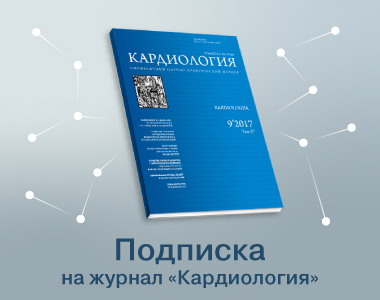Pressure and Volume Characteristics of the Left Ventriclе in Its Diastolic and Systolic Dysfunction
https://doi.org/10.18087/cardio.2019.4.2647
Abstract
The Aim of the study was a detailed investigation of pressure volume-loop (PV-loop) curves in the rat heart during development of doxorubicin cardiomyopathy. Materials and methods. Cardiomyopathy in rats has been developed after 4 weeks doxorubicin administration (2 mg / kg weekly). Results. Echocardiographic study of rats in 8 weeks from onset of doxorubicin administration showed preponderance of systolic dysfunction (67 %) with decrease of left ventricular (LV) ejection fraction (EF) by 30 %. Simultaneous registration of LV pressure and volume showed that diastolic LV volume was preserved in doxorubicin-treated rats due to considerable lengthening of the diastole, the heart rate was reduced by 22 %. These hearts also showed slowing of relaxation, reduced maximal rate of pressure development and stroke work, as well as significant reduction in peripheral arterial resistance. Diastolic dysfunction differed from the systolic one by normal systolic EF and preserved LV contractility index as well as lower diastolic LV pressure throughout the diastole. Conclusions. Based on these data, four compensatory mechanisms associated with cardiomyopathy were distinguished - 1) slowing of myocardial relaxation, prolonging myofibrillar active state, 2) reduction of peripheral arterial resistance for easier LV ejection, 3) heart rate reduction, prolonging diastolic pause and thus facilitating better LV filling and 4) increased pressure in the small circle, also contributing to the LV rapid filling.
About the Authors
A. A. AbramovRussian Federation
researcher
V. L. Lakomkin
Russian Federation
A. V. Prosvirnin
Russian Federation
V. I. Kapelko
Russian Federation
References
1. DeSantis CE, Lin CC, Mariotto AB, Siegel RL, Stein KD, Kramer JL et al. Cancer treatment and survivorship statistics, 2014: Cancer Treatment and Survivorship Statistics, 2014. CA: A Cancer Journal for Clinicians. 2014;64(4):252–71. DOI:10.3322/caac.21235
2. Bottone AE, Voest EE, de Beer EL. Impairment of the actin-myosin interaction in permeabilized cardiac trabeculae after chronic doxorubicin treatment. Clin Cancer Res. 1998;4(4):1031–7. PMID:9563899
3. Yeh ETH, Tong AT, Lenihan DJ, Yusuf SW, Swafford J, Champion C et al. Cardiovascular Complications of Cancer Therapy: Diagnosis, Pathogenesis, and Management. Circulation. 2004;109(25):3122–31. DOI: 10.1161/01.CIR.0000133187.74800.B9
4. Lakomkin V.L., Abramov A.A., Gramovich V.V., Vyborov O.N., Lukoshkova E.V., Ermishkin V.V., Kapelko V.I. The Time Course of Formation of Systolic Dysfunction of the Heartin Doxorubicin Cardiomyopathy. Kardiologiia. 2017;57(1):59–64. DOI:10.18565/cardio.2017.1.59-64
5. Orlova Ts.R., Kapelko V.I. Rate constants of left ventricular relaxation: the effect of inotropic and mechanical factors. Kardiologiia. 1986;26(6):79–83. PMID: 3761810
6. Lakomkin V.L., Abramov A.A., Gramovich V.V., Vyborov O.N., Lukoshkova E.V., Ermishkin V.V., Kapelko V.I. Relationship between diastolic and systolic myocardial dysfunction at doxorubicin cardiomyopathy. Kardiologicheskij Vestnik. 2018;13(2):49–54. DOI: 10.17116/Cardiobulletin201813248
7. Kass DA, Maughan WL, Guo ZM, Kono A, Sunagawa K, Sagawa K. Comparative influence of load versus inotropic states on indexes of ventricular contractility: experimental and theoretical analysis based on pressure-volume relationships. Circulation. 1987;76(6):1422–36. PMID:3454658
8. Writing Committee Members, Hunt SA, Abraham WT, Chin MH, Feldman AM, Francis GS et al. ACC/AHA 2005 Guideline Update for the Diagnosis and Management of Chronic Heart Failure in the Adult: A Report of the American College of Cardiology/American Heart Association Task Force on Practice Guidelines (Writing Committee to Update the 2001 Guidelines for the Evaluation and Management of Heart Failure): Developed in Collaboration With the American College of Chest Physicians and the International Society for Heart and Lung Transplantation: Endorsed by the Heart Rhythm Society. Circulation [Internet]. 2005 [cited 2019];112(12). DOI:10.1161/CIRCULATIONAHA.105.167586
9. Borlaug BA, Kass DA. Invasive Hemodynamic Assessment in Heart Failure. Heart Failure Clinics. 2009;5(2):217–28. DOI: 10.1016/j.hfc.2008.11.008
10. Kapelko V.I. Role of the relaxation process in contractile function disturbance in various heart pathologies. Biulleten’ Vsesoiuznogo kardiologicheskogo nauchnogo tsentra AMN SSSR. 1982;5(1):99–107. PMID: 7046765
11. Kapelko V.I., Lakomkin V.L., Lukoshkova E.V., Gramovich V.V., Viborov O.N., Abramov A.A. Complex study of the rat heart at isoproterenol damage. Kardiologiia. 2014;54(3):46–56. PMID: 25102749
12. Farr G, Shah K, Markley R, Abbate A, Salloum FN, Grinnan D. Development of Pulmonary Hypertension in Heart Failure With Preserved Ejection Fraction. Progress in Cardiovascular Diseases. 2016;59(1):52–8. DOI:10.1016/j.pcad.2016.06.002
13. Vachiéry J-L, Adir Y, Barberà JA, Champion H, Coghlan JG, Cottin V et al. Pulmonary Hypertension Due to Left Heart Diseases. Journal of the American College of Cardiology. 2013;62(25):D100–8. DOI:10.1016/j.jacc.2013.10.033
14. Lam CSP, Roger VL, Rodeheffer RJ, Borlaug BA, Enders FT, Redfield MM. Pulmonary Hypertension in Heart Failure With Preserved Ejection Fraction. Journal of the American College of Cardiology. 2009;53(13):1119–26. DOI:10.1016/j.jacc.2008.11.051
15. Kapelko V.I., Novikova N.A., Pshennikova M.G., Meerson F.Z. Correlation of the parameters of myocardial contraction and relaxation in compensatory cardiac hypertrophy. Kardiologiia. 1979;19(9):88–91. PMID: 158670
16. Maeda A, Honda M, Kuramochi T, Takabatake T. Doxorubicin cardiotoxicity: diastolic cardiac myocyte dysfunction as a result of impaired calcium handling in isolated cardiac myocytes. Jpn Circ J. 1998;62(7):505–11. PMID:9707007
17. Veksler V.I., Levitskaya E.L., Khatkevich A.N., Orekhova I.V., Khuchua ZA, Kapelko V.I. Myocardial adaptation to long-term action of substances associated with decreased intensity of cardiac function. Biochem Med Metab Biol. 1994;53(1):8–15. PMID:7857685
18. Sunagawa K, Maughan WL, Burkhoff D, Sagawa K. Left ventricular interaction with arterial load studied in isolated canine ventricle. American Journal of Physiology-Heart and Circulatory Physiology. 1983;245(5):H773–80. DOI:10.1152/ajpheart.1983.245.5.H773
19. Kelly RP, Ting CT, Yang TM, Liu CP, Maughan WL, Chang MS et al. Effective arterial elastance as index of arterial vascular load in humans. Circulation. 1992;86(2):513–21. PMID:1638719
20. Borlaug BA, Kass DA. Mechanisms of Diastolic Dysfunction in Heart Failure. Trends in Cardiovascular Medicine. 2006; 16(8):273–9. DOI: 10.1016/j.tcm.2006.05.003
21. Ohara T, Ohte N, Little WC. Pulmonary hypertension in heart failure with preserved left ventricular ejection fraction: diagnosis and management. Current Opinion in Cardiology. 2012;27(3):281–7. DOI: 10.1097/HCO.0b013e32835220b1
22. Parin VV. The rôle of pulmonary vessels in the reflex control of the blood circulation. Am J Med Sci. 1947;214(2):167–75. PMID:20257476
Review
For citations:
Abramov A.A., Lakomkin V.L., Prosvirnin A.V., Kapelko V.I. Pressure and Volume Characteristics of the Left Ventriclе in Its Diastolic and Systolic Dysfunction. Kardiologiia. 2019;59(4):45-51. (In Russ.) https://doi.org/10.18087/cardio.2019.4.2647















